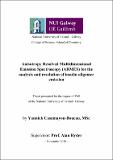| dc.description.abstract | Protein aggregation is one of the biggest challenges affecting the manufacture and safe use of biopharmaceuticals. Despite efforts made to enhance protein stability [1], aggregation still remains a critical factor in product safety [2] as it can affect bioavailability and increase immunogenicity problems [3-4]. Aggregation can occur at every step of the bio-pharma process, from production to protein delivery and can be induced by a multitude of factors [5]. Detecting and quantifying protein aggregation is a considerable analytical challenge, due to the often unknown nature of the aggregates, their wide size range (nm to mm) [6] and the varying concentration ranges encountered. Within the aggregate family, being able to detect the soluble nm size aggregates is probably the most difficult/critical part as they form the seeds of bigger aggregation issues [7-8]. Many current methods for aggregation monitoring are either destructive, only capable of measuring large precipitated aggregates, expensive/time-consuming and/or affect the original distribution of oligomers in the sample [9]. Therefore, better analytical methods that are capable of identifying and quantifying small soluble aggregates are needed. The methods must deliver good robustness, high sample throughput, ease of use and low cost required for use as a process analytical technology (PAT) tools.
Protein analysis by intrinsic fluorescence is very attractive because in addition to being fast, non-destructive, sensitive and inexpensive, it is also non-invasive and completely preserves the structure and behavior of proteins as well as the potential distribution of oligomers [10]. The major issue however is that the multiple fluorophores present in proteins are generally in close proximity (<15 nm) and thus interact photophysically, resulting in a complex emission space and highly overlapping signals. Multidimensional fluorescence spectroscopy (MDF) measurement techniques like excitation-emission matrix (EEM) [11] and total synchronous fluorescence scan (TSFS) [12], can be coupled with factor based chemometric methods to partially overcome this issue by deconvoluting the MDF data and resolving fluorophore contributions. Recent work in Alan Ryder’s group has shown that more and better information could be obtained if MDF is combined with anisotropy (r) [13-14], which is related to rotational speeds and hydrodynamic volumes, and thus molecular size. This method was called Anisotropy Resolved Multidimensional Emission Spectroscopy (ARMES) [14] and is the foundation for this research.
The first part of this thesis project was to improve the ARMES hardware and enable the acquisition of polarized emission in the important tyrosine/tryptophan region. This was solved by replacing the classically fitted thin film polarizers with wire grid polarizers that have a better UV transmittance. To correct for the weak efficiency of these filters in the important protein region, the wire grid polarizers had to be used in pairs. The efficacy of these new filters was validated with various anisotropy standards, and a homebuilt fitting was designed to mount them in the sample compartment of the spectrofluorometer (Chapter 3, Casamayou-Boucau et al. [15], 2017).
The use of UV transmitting filters resulted however in the elimination of the spectral reshaping previously observed in the TSFS-ARMES studies [13-14], which had consequences on the structure of the TSFS data being generated. Two mixtures of non-interacting fluorophores were used to investigate that issue and standardize the chemometric methodology to be used. The results from this study showed for the first time how to accurately model component anisotropy using multivariate curve resolution (MCR) from data collected using TSFS or EEM. The change in TSFS data structure was also confirmed and their non-trilinear behaviour restored. While the correct data augmentation strategy enabled TSFS to yield acceptable results, EEM data proved to be more accurate once an efficient method was found to remove Rayleigh scatter (Chapter 4, Casamayou-Boucau et al. [16], 2018).
Having improved and validated ARMES hardware and chemometrics, the method was ready to be applied to intrinsic fluorescence analysis of insulin. The work in this thesis focused on the analysis of small soluble non-covalent aggregates of human insulin, which are difficult to differentiate spectroscopically [17] and not suitable for conventional size exclusion chromatography (SEC) [18]. By carefully dissecting the EEM-ARMES measurement into pure scatter and fluorescence information, unique tools such as the polarized 1st order Rayleigh scatter band, the scatter depolarization, and the denoised aniso-MDF spectra could be used to assess, either qualitatively or quantitively, the degree of insulin aggregation (Chapter 5). Furthermore, due to the location of insulin’s tyrosine residues in the regions responsible for dimer and hexamer formation, it was possible for the first time to resolve the intrinsic fluorescence of insulin and detect clearly the presence of internal energy transfer (Chapter 5). The linear dependencies usually observed were broken, permitting the building of robust models for discriminating the small soluble insulin aggregates. Thus Chapter 5 demonstrated the potential of ARMES for protein analysis and showed how multiple probes were obtained in a single non-invasive measurement. | en_IE |


